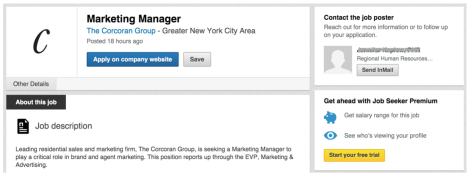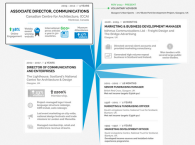Regular readers know that I’m a huge proponent of networking in the job search and that I don’t consider a job application truly complete until you’ve networked. Being a skilled networker gets your resume out of the black hole and (assuming you’re qualified for the role you applied to) often lands you an interview.
While reaching out to warm connections (perhaps a friend of a friend) is better than reaching out to strangers, cold emails can and do work.
Over the next few posts, I will be doing a series on cold emails. To kick off, let’s discuss who you should be sending cold emails to since the person you reach out to is just as important as the content itself.
Your goal is to reach the person who is:
A. Most likely to help you out
B. Has the actual authority or involvement in the decision-making process to help you out
Here are four types of people you can choose from to send your cold email to. It’s not an exact science, so for each job you are networking for, you’ll need to use your best judgment on who the best person might be.
Option 1: The actual job poster!
It is rare, but there are actually times when you will know exactly who is screening applications for a job. If a job is posted on LinkedIn, the company has the option to make the poster visible like in the top right corner below. Thank you LinkedIn for another amazing feature!

If you know who posted the job, you know exactly who to reach out to. You might also find this info in the job description, but in my experience that is pretty rare.
Option 2: The Hiring Manager
If you don’t know the job poster, one of the best people you can get to with a cold email is the hiring manager. After all, this is probably the person that is feeling the most pain by having the role open and therefore is the most motivated to fill it quickly. The hiring manager also knows most about the job and the type of person they want to hire, often times, more so than the recruiter. Because of this, they can make a quick judgment upon looking at your resume.
Sometimes job descriptions will actually tell you the title of the person that the role is reporting to like in the example below:

Other times you’re going to have to guess a bit. If you’re applying for a Digital Marketing Coordinator role you probably want to search for the Digital Marketing Manager. You can go even broader and look at everyone with the word “marketing” in his or her job title. For small and mid-sized companies, it is usually possible to find this person easily using LinkedIn.
Option 3: The in-house recruiter
The next type of person you should consider reaching out to is a member of the in-house recruiting team. Often times, the recruiter is in charge of the first screen for any job (the hiring manager has to do their day job) and so they are the decision maker at that point in the process.
People with recruiting responsibilities can have a handful of different titles but I generally recommend searching for the keywords “recruiter”, “recruiting”, or “talent acquisition”. More often than not, one of these three terms will find you the right group of people.
In larger companies you’re not going to know which recruiter is working on the exact job you applied for, but you can be pretty confident that they will know which person on their team to pass your email along to.
Option 4: Someone you can establish common ground with
I like this approach a lot as well. If you went to a university where alumni are eager to help each other out, finding an alum who works at the company you just applied for can be great.
If you can find an alum who works on the same team that the role is on or is a recruiter, that’s even better.
If your school doesn’t foster alumni support, you might want to reach out to someone else who you have something in common with. I like looking for people who have made a similar move that you’re trying to make, perhaps from your current company to the future company or one industry to another. Someone who has been in your shoes and successfully made the move may be more willing to pay it forward.
Now that you know who you’re going to reach out to, check out this post on how to use LinkedIn to find valuable networking contacts. As part of this series, we will also have a post on how to find someone’s email address in order to send a cold email.
Who do you reach out to when sending cold emails? What else do you want to know about cold emails for this series? Leave a comment!





